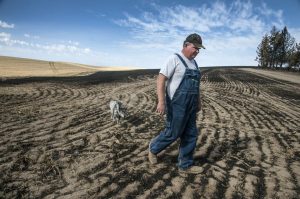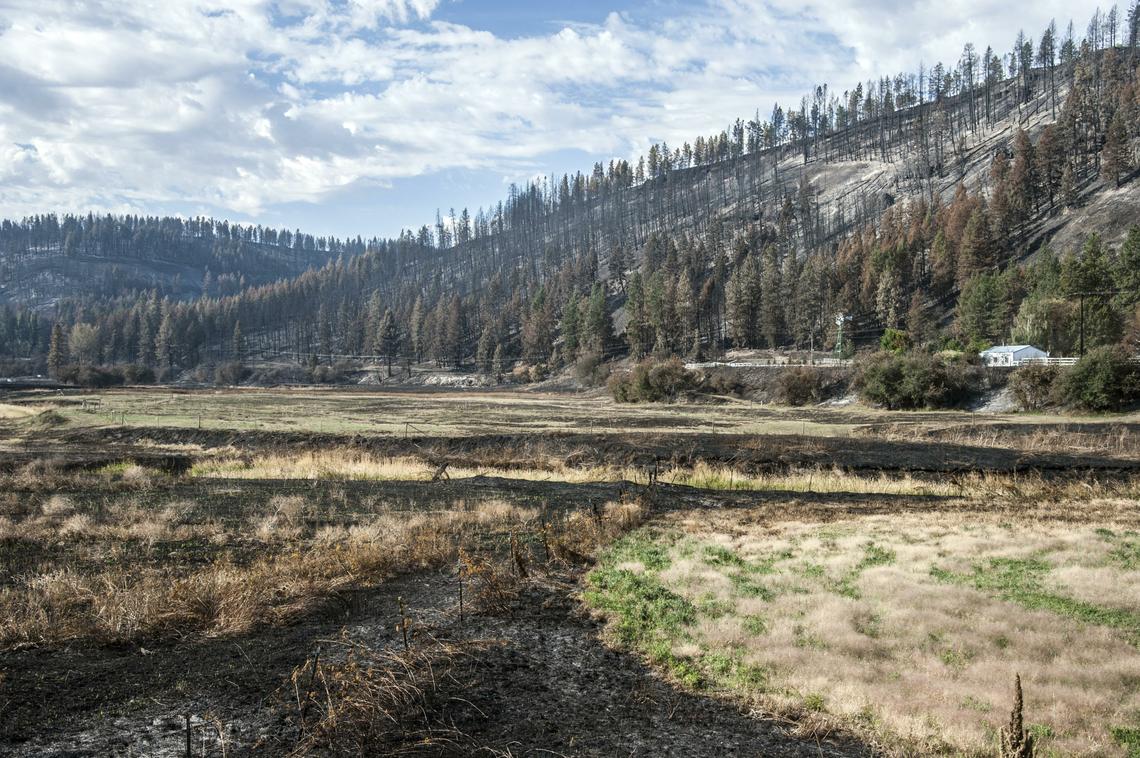Rural landowners assert role in fighting wildfires
by Chad Sokol

Wildfires in rural Washington have again brought complaints from farmers and property owners about their role in protecting their land.
The fire in Valleyford has been out for a week, for instance, but Jack Lacher is still fuming.
When the farmer spotted a pillar of smoke on the other side of a canyon, he quickly started alerting neighbors. Soon afterward, dozens of farmers were driving tractors through the stubble fields, stirring up dirt to bury flammable wheat straw. Some had water trucks and excavators, too.
Lacher said “the farmers probably did 90, 95 percent” of the firefighting that day. While professional firefighters responded, Lacher and some of his neighbors claim they were slow and ineffective.
“They spent most of their time sitting on the road,” Lacher said. “When they finally got here, all they were doing was sitting by structures.”
The Yale Road fire quickly consumed nearly 4,000 acres of brush, field and forest, destroying 10 homes and several outbuildings. Some farmers lost valuable crops, although most of their wheat had already been harvested.
But firefighters say it could have been worse. Two other fires started within the same hour on Aug. 21 – the Wellesley fire in north Spokane and the Hart fire in northern Lincoln County. Suddenly, crews and equipment needed to be in three places at once, and multiple agencies needed to establish a chain of command.
“Getting all those resources in there, and managing them all once they get there, it’s a huge task,” said Jay Cronk, a farmer who volunteered for 26 years with Spokane County Fire District 8. “Radio traffic is just crazy. It’s a crazy time.”
Signs hand-painted with “Thank You Firefighters” now dot the unpaved roads of Valleyford, some with the addition of “+ Farmers.” Throughout the area, tractor lines separate charred earth from untouched sections of wheat fields – a sign the farmers’ efforts paid off.
“The farmers did a hell of a lot of work to put out the fire,” Fire District 3 Chief Bruce Holloway said. “But I know my guys busted their asses, too.”
Last year, the state Department of Natural Resources was criticized for its handling of the 2014 Carlton Complex of fires in Okanogan County.
In a January 2015 hearing, state Rep. Joel Kretz, a Wauconda Republican who spent time in the fire zone, said firefighters performed admirably when they were dispatched, but the command structure was complicated and decision-making slow.
Okanogan County residents said they had trouble getting permission to assist in the firefighting effort. Kretz later introduced a bill that would give locals access to state lands to build fire lines, clear brush and timber, and suppress wildfires with water. That bill didn’t pass, although other measures to improve firefighting did.
Gary Gunning, whose family developed the Northwood area near Spokane Valley and who owns an excavating company, said he drove a water truck to Spokane after hearing about the Wellesley fire, which narrowly missed his brother-in-law’s home on Beacon Hill.
Gunning said he has years of experience putting out brush fires, and all the proper equipment. But when he arrived at his brother-in-law’s property, a fire official refused to let him in, he said.
“As soon as he left, we went in the backyard and started putting out hot spots,” Gunning said. “I understand their point of view, protecting the public and all that, but sometimes they get carried away with their rules.”
The Yale Road fire started on the edge of Fire District 3 and spread rapidly to the northeast, into District 8. Several departments contributed to the response, with some firefighters working for days.
Lacher accused firefighters of “sitting around and watching,” and a neighbor said they let the fire burn too close to his home. But Holloway, the Fire District 3 chief, and District 8 Chief Tony Nielsen said firefighters needed to consider their own safety.
“If the fire was out there in the field and they could get access to it, they should do that immediately,” Holloway said. “But if the fire was down there on a hillside, steep terrain, you might have to wait for it to come out the top so you can start fighting it from there.”
Nielsen added, “Too many firefighters have been killed by getting into those spaces and getting flanked by fire.”
If firefighters appeared to be “babysitting” a home, Nielsen said, they were probably a “structure protection group” using a truck specially designed for that purpose.
Wildland trucks are more rugged, with four-wheel drive and lighter hoses, he said. Urban trucks are “really not even meant to be off the pavement.”
Blake Marlow, a Freeman resident who works with Lacher, said, “I don’t think the local resources were as equipped as some of the farmers around here.”
The Department of Natural Resources, which maintains the state’s largest corps of firefighters, provided personnel, bulldozers and aircraft. And Nielsen said the county’s new radio system made communication easier.
Nielsen said he has talked to farmers, including Lacher, about their concerns.
“I take it seriously, and I take it personally,” he said. “Firefighters are their own worst critics.”
Holloway added, “Anytime you have a big fire, you’re going to look back and see something you could have done better.”
Cronk, the former District 8 volunteer, said firefighters could have done more to protect some properties, but he’s glad no one was hurt.
“I do see both sides of it, because quite a lot of my father-in-law’s property got burned,” he said. “But life and safety are the first priorities, and I’m sure they will continue to be.”
Free Range Report Admin.
